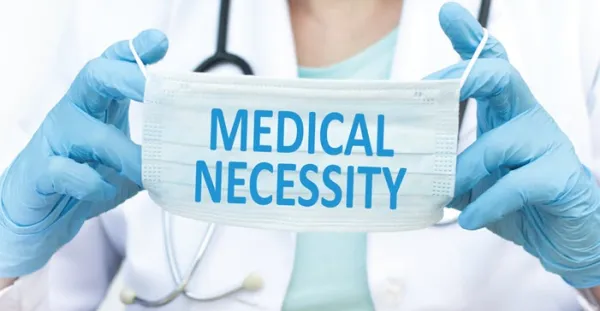Pediatric Coding Alert
Know the Ins and Outs of Medical Necessity
Also: get expert advice on establishing a risk assessment. As a coder, you understand that medical necessity is important, but how deep is your understanding of its impact on your practice? Here, we’ll examine the definition of medical necessity and offer our experts’ advice on how you can shore up holes that could trigger an audit. What Is Medical Necessity? Definitions of the term are, unsurprisingly, varied and vague. However, there is some consensus among various medical institutions, according to Kim Huey, MJ, CPC, CPCO, COC, CHC, CCS-P, PCS, president, KGG Coding and Reimbursement Consulting and Sandy Giangreco Brown, BS, RHIT, CHC, CCS, CCS-P, CPC, CPC-1, COBGC, COC, PCS, director of coding and revenue integrity at CLA in their HEALTHCON 2021 presentation “Medical Necessity: Defining and Documenting to Support Billing.” To meet the criteria of medical necessity, Huey and Brown explain that services should be: Know the Difference Between Medical Necessity and Clinical Judgment Medical necessity is the justification for a specific treatment or service based on a patient’s medical condition, while clinical judgment is the decision-making process healthcare professionals use to determine the best course of action for the patient. Both are essential in providing appropriate and effective patient care, and they’re certainly interrelated. Where physicians sometimes get tripped up is separating their clinical expertise with what payers deem medically necessary. “Doctors have the license to practice medicine. They can practice medicine as they see fit. They can’t dictate if someone’s going to pay for something,” said CJ Wolf, MD, CPC, COC, CHC, educator and compliance executive in Salt Lake City, Utah during his HEALTHCON 2023 presentation, “Monitoring Medical Necessity: Do You Need Help?” When a provider tries to show medical necessity by expressing their clinical judgment, that’s the kind of thing that can trigger an audit. For example, let’s say a 5-year-old comes in for their well-child visit and the pediatrician notices a small, asymptomatic skin lesion on the child’s arm. They decide to perform a skin biopsy to rule out potentially serious issues, even though there are no concerning symptoms. The provider might deem this necessary, but these kinds of claims will likely raise red flags as the procedure would appear to not be related to the patient’s health. Remember That Quantity Does Not Equal Quality Documentation The Centers for Medicare & Medicaid Services (CMS) has always maintained that medical necessity is the fundamental basis of payment. But it’s still a common misconception that since history and physical exam haven’t directly contributed to office/outpatient E/M code selection since 2020, there is no reason to spend time documenting the history and examination. Proving medical necessity is one good reason, however. For example, when selecting outpatient E/M codes, you must ensure that the chosen codes accurately represent the level of service provided. The chosen level of E/M code, in turn, should match medical decision making or amount of time on the date of the encounter needed to manage the patient’s condition(s). Documentation of history, examination, and the decision-making process can all support the medical necessity underlying the level of service reported, and payers may deny reimbursement for services if they believe the E/M code does not align with the medical necessity of the provided services. Example: If you report 99214 (Office or other outpatient visit for the evaluation and management of an established patient, which requires a medically appropriate history and/or examination and moderate level of medical decision making. When using time for code selection, 30-39 minutes of total time is spent on the date of the encounter.) but the documentation only shows that a patient had congestion, a sore throat, and the pediatrician diagnosed a common cold, that code will surely raise a red flag to the payer without significantly more information explaining the moderate level of the service or 30–39 minutes of time spent with the patient. So, now that you realize the ways a practice can fall short of its medical necessity due diligence, how can you check your own practice’s patterns? Establish a Risk Assessment There are several ways your practice may not be in compliance for medical necessity, and it’s always best to take care of problems before they become patterns that auditors start to see. “If you’re not doing a risk assessment, you need to. What that entails is not just the compliance officer going through and picking out this, this, and this. You’re talking with other people. You’re getting other people in the organization involved,” said Wolf. Here are a few tips on how to get started: Based on what you find during the assessment, set up a system within your practice to regularly monitor the most problematic areas. Then make sure to keep up with it. “Make it a policy to do a comprehensive, system-wide risk assessment once a year,” advised Wolf. The CEO, CFO, COO, and the quality officer should all be involved, he advised. Expert tip: Focus first on your bread-and-butter services. “I always ask people to tell me the top 10 codes that represent 80 percent of your revenue,” said Wolf. “Focus first on the big-ticket items,” he continued. For more information, the U.S. Department of Health and Human Services (HHS) Office of Inspector General (OIG) offers compliance guidance to a variety of segments of the healthcare industry (https://oig.hhs.gov/compliance/compliance-guidance/).


Related Articles
Pediatric Coding Alert
- Documentation:
Focus on Communication to Improve Documentation
Here’s a helpful acronym to take back to your provider. One of the biggest takeaways [...] - Case Study Corner:
Get Into Gastroenteritis to Code This Case
Follow this case from initial visit to follow-up for clear coding guidance. As pediatric coders, [...] - Practice Management:
Know the Ins and Outs of Medical Necessity
Also: get expert advice on establishing a risk assessment. As a coder, you understand that [...] - You Be the Coder:
Know When to Lean on Laterality
Question: My provider performed two button removals for undescended testes surgery. The provider performed surgery [...] - Reader Questions:
Get to the Bottom of This Wound Repair Encounter
Question: Our provider saw a 7-year-old who cut their left foot on a broken wood [...] - Reader Questions:
See the Subtle Differences That Affect this Colitis Case
Question: Our provider documented a 10-year-old patient as having both diarrhea and colitis. Do I [...] - Reader Questions:
Assess This Category II Assessment Code Conundrum
Question: We are not able to get any payers to cover 3085F when billed with [...]




